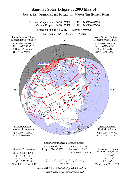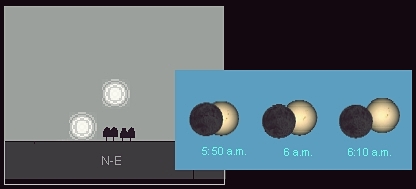
- - text and links as of last publication - -

An annular eclipse is taking place on May, 31st, near the polar regions. An annular eclipse is a total eclipse where the disk of the Moon -as the Moon is farther from the Earth than during a total eclipse- is smaller than the Sun's disk and does not cover it entirely, as it does for a total eclipse, but let a fringe of Sun around it. The main interest of this eclipse is in the way it works. It is a kind of "over the pole" eclipse: the sunlit side of the Earth is on the side of China and Japan, and so the Moon. North-America and the Atlantic ocean are in the night part of the Earth. The Moon's shadow, projected by the Sun is passing over the pole and is grazing the Earth in the Arctic ocean, above Iceland. Besides, the northern edge of the shadow is not reaching Earth. Hence the really peculiar aspect of the eclipse: it has a 1200 km wide zone of totality; it is moving westwards as seen from the night-darkened side of the Earth (which is unusual as eclipses are moving eastwards but which is normal given the configuration of the eclipse); and as one edge of the shadow does not reach the Earth, the southern part of the eclipse's path is instead defined by the day-night terminator. This eclipse, so, is not so much worth looking at as such but due to the fact of its peculiar shape. Think that the Moon's dark disk will be coming from Pacific from over the pole
 | click to a orthographic map of the May, 31st, 2003 eclipse |
The eclipse is total annular on a line going from north of Glasgow (Scotland) to off-west coast of Greenland. Due to the peculiar circumstances as described above, the path of annularity has an extra-ordinary shape: it is D-shaped, 1200 kilometers wide at its maximum. The annularity starts in Scotland, above Glasgow, at 03:45 UT and heads northwest to off-coast of Greenland where it ends at 04:31 UT. The maximum of the eclipse is north-west of Iceland, in the Strait of Denmark -4:08 UT, duration 3mn 37 seconds, Sun 2.9° above the horizon. Generally, in the zone of totality, the Sun is low on the horizon, 2 or 3 ° and the duration is about 3 minutes 37 seconds. The annular eclipse is partial for diverse zones (from Alaska to Western Europe), at diverse times and conditions (from the afternoon of the day before in Alaska to sunrise in Europe; it is important in Russia, in Helsinki and Berlin, etc). For more details see at the good site address of which just follows. The thumbnail below leads to a global view of the circumstances of the eclipse (path of annularity, zones of partial visibility. The map is courtesy of Fred Espenak, NASA/Goddard Space Flight Center. For more materials about this eclipse, and eclipses in general, see Fred Espenak's Eclipse Home Page where one may find a lot of diverse data and details about local conditions
 | click to a view of May, 31st eclipse as seen from East of France |
For western Europe, an example of the event is given here under. It is the aspect of the eclipse, at sunrise, for east of France. For more about the eclipse in France, see the SAF site
For how an eclipse works and how to observe one, see the tutorials "Sun Eclipses" and "Observing a Sun Eclipse". Remember that observing an eclipse is as dangerous as usually observing the Sun. In the second tutorial, you will find advices about these dangers. Do not forget to see them!
Observation Reports: eclipse watchers where the sun was rising eclipsed had a very delightful sight. It seems they had bad weather in Iceland where the eclipse was total annular but observations were possible anyway. A good idea when one has no direct view towards the eclipse is to watch projected cescent sunbeams of the Sun hitting diverse surfaces (ground, buildings walls, etc). They had a gallery at SpaceWeather.com and might be accessible again (but it takes now to use the "Archives" page and look about the date of the eclipse (May, 31st))
Website Manager: G. Guichard, site 'Amateur Astronomy,' http://stars5.6te.net. Page Editor: G. Guichard. last edited: 12/28/2010. contact us at ggwebsites@outlook.com